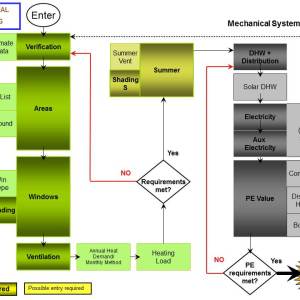Building Efficiency and Blower Doors
Building Efficiency and Blower Doors: Essential Responses to Sandy: By Ken Levenson,
Superstorm Sandy has produced a torrent of meetings, plans, reports, announcements and actions by city, state, federal and non-governmental organizations. Today, before their terms expire, the New York City Council and Mayor are racing to pass important legislation based on these past months of herculean effort. While the action may be understandably focused on measures directly related to storm survival of our built environment from wind and flood damage, systemic failures of water, transportation, power and other services — legislative efforts thus far have focused on the symptoms of our problems and not the root causes.
One of the most important root causes are today’s woeful standards of building energy efficiency (BEE). Fundamental weaknesses in New York’s resilience exposed by Sandy directly related to, and can be effected by, BEE are easy to list:
The climate crisis is now, therefore greenhouse gas emissions must be dramatically reduced to mitigate the increasing scale of future storms;
Our power grid is fragile, but dramatically reduced power consumption can provide the basis for a more diverse and robust grid; and
The sheltering capacity of our buildings is generally poor, meaning that without power in extreme temperatures occupants suffer. However buildings that require no energy to maintain habitable temperatures can safely provide sheltering in place year round. The Urban Green Council Building Resiliency Task Force report to the Mayor and City Council Speaker identifies this quality in proposal #27 “Maintain Habitable Temperatures Without Power”.
Because BEE is essential to our storm resilience it should be concretely addressed in the response to Sandy by the City Council and Mayor. Thus far, City BEE efforts have been segregated within PlaNYC, and while this trailblazing initiative has achieved significant gains in energy efficiency, it too focuses heavily on the symptoms of our buildings’ problems and not their root causes. For example, while PlaNYC has addressed the critically important aspect of mechanical systems commissioning and their efficient operation, PlaNYC does not significantly address what is making the loads so big and the systems so large in the first place. The root cause of this deficiency is the actual building construction. While building construction is complicated, an initial and significant response addressing it and the resulting efficiency need not be. Real progress can be made in tackling the root causes by focusing on measuring the airtightness of building enclosures and making them airtight.
Why specifically airtightness? Because it is fundamental — the cornerstone of an energy efficient (as well as comfortable and healthy) building. Airtightness is even more important than thermal insulation. A leaky building compared with an airtight one, otherwise similarly thermally insulated, can have up to five times more heat losses. [1] Air leaks are the biggest liability in regards to BEE.
As such airtightness is also the essential physical metric of the world’s most rigorous building energy standard, Passive House. Passive Houses, be they apartment buildings, office buildings or schools are very airtight and energy efficient — achieving up to 90% reduction in heating and cooling energy demand from typical buildings existing today, while being very comfortable, healthy and affordable. And a Passive House building without power should provide safe shelter through the coldest days of the year as it achieves an indefinite interior temperature equilibrium of approximately 55 degrees.
Today, airtight Passive Houses are soaring in popularity across the globe. New York City now has dozens of projects totaling over 150,000 SF of either complete or under construction Passive House projects. The world-wide leader is not in Germany, but is Brussels, Belgium. This northern European capital has gone from zero square feet of Passive House in 2007 to over 3.5 million square feet today and government regulation mandating Passive House for all new and substantially renovated private and public buildings starting in 2015. As Brussels and others are demonstrating the Passive House real-world feasibility, the challenge should no longer be why we can’t do it, but instead, how can we do it. And the first step in answering how, is by specifically focusing on airtightness.
Photo: Charlie HoxieFortunately a building’s airtightness can be readily measured, at minimal cost, with a blower door test. A blower door is a programmable fan device that can pressurize and depressurize the building’s interior volume of air, to determine how tight or leaky the building enclosure is. When a blower door test is done air leaks can be quantified, located and sealed — making a more airtight, efficient and resilient building. And while Passive House may not be suitable or desired for every building, greater airtightness is.
It is critical — like checking the air in our car tires, flossing our teeth and eating less fat, salt and sugar, by way of comparison — that airtight building enclosures be made a normal part of our more sustainable lives.
With the benefits of greater airtightness in focus as the post-Sandy maelstrom continues, New York City should pass a law that mandates blower door testing and reporting to the Department of Buildings as an essential first step in making airtightness the new normal.

